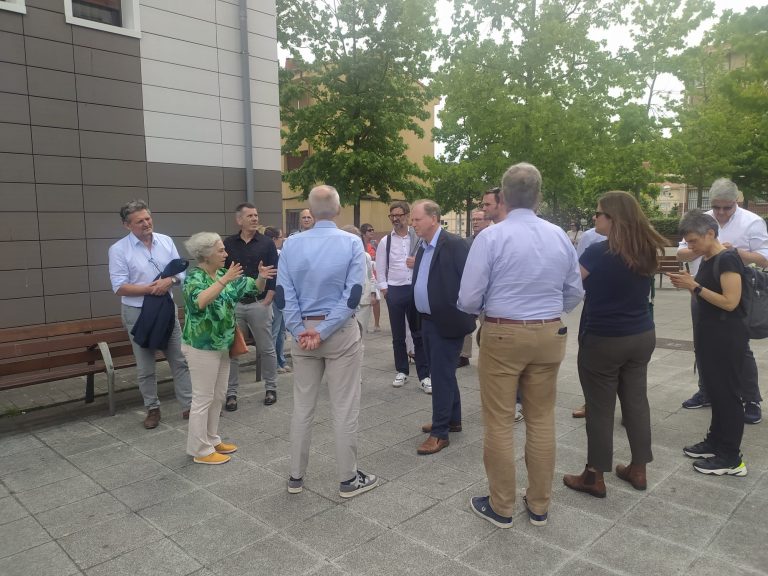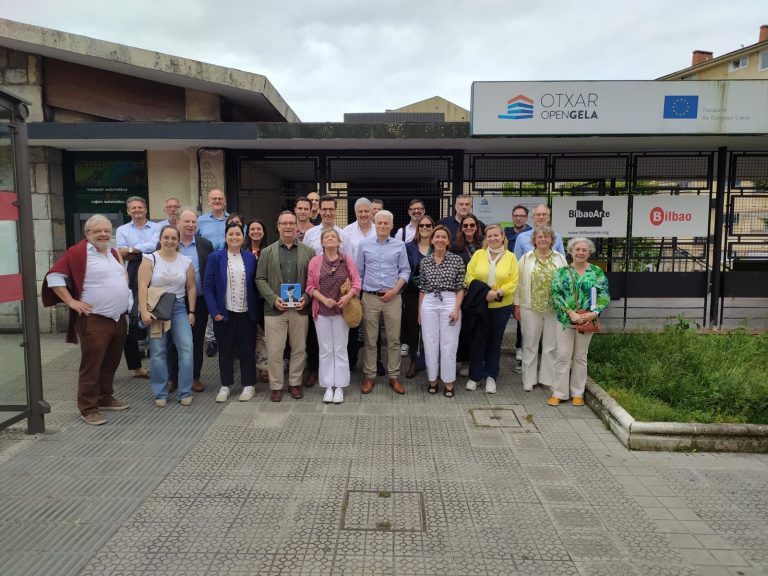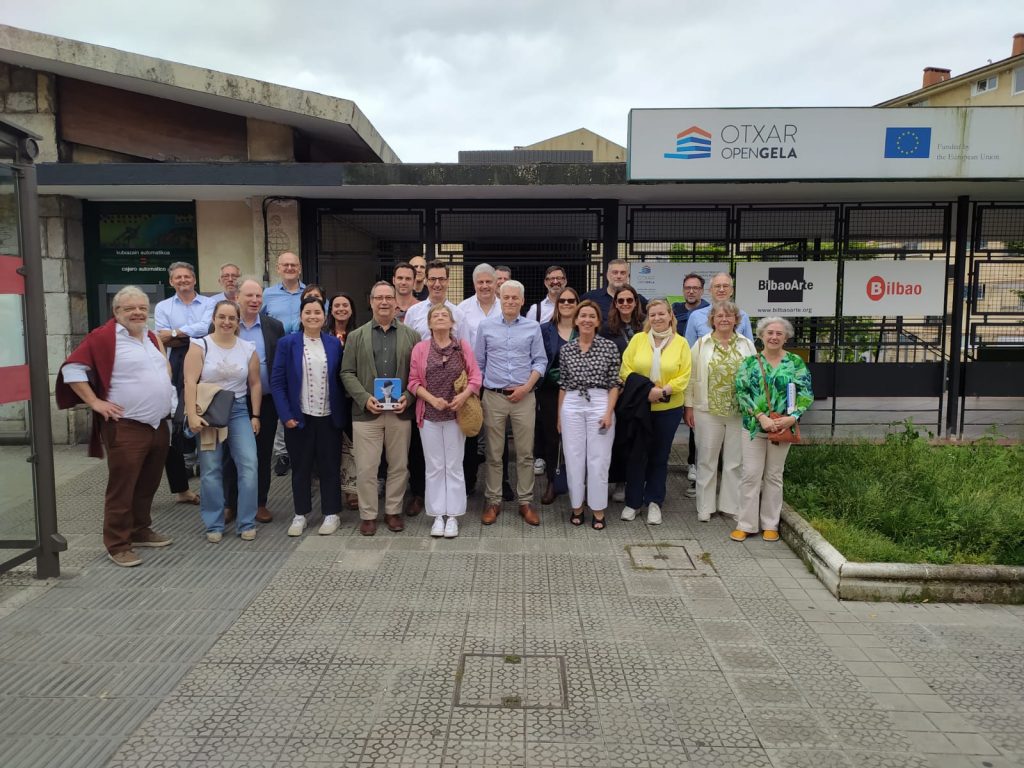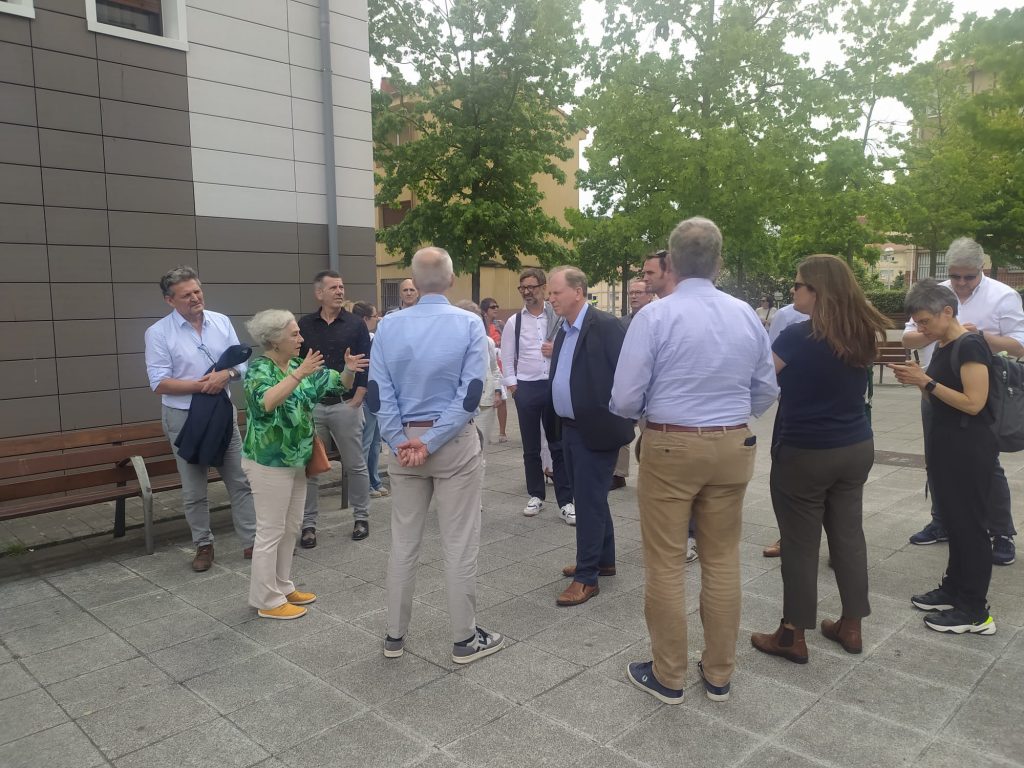Alex Carrascosa EDE Fundazioko aholkularia da, Opengela programa garatzen ari den BIRTUOSS proiektuko bazkide gisa parte hartzen duen erakundeetako bat. Entzuteko lan baten bidez, hirien berroneratzea zabaltzea ardatz duen programa europar honetan parte hartzen duten pertsona guztien testigantzak jasotzen ditu: haien kezkak, kexak, balorazioak, hobetzeko proposamenak, etab.
Elkarrizketa honetan, fundazioak proiektuan izan duen zeregina azaldu du, eta Txonta eta Otxarkoaga auzoetako esperientzia pilotuetan parte hartu duten pertsonek hurbiltasun-bulegoen (‘opengelen’) zerbitzuari buruz 2023. urtearen amaieran egin zuten azterketaren xehetasunak eman ditu: elaborazio-prozesua, zerbitzuan hautemandako ahuleziak eta indarguneak, ikasitako lezioak, hobekuntza-proposamen aipatuenak eta azterlanetik atera zituzten ondorioak.
Zein da EDE Fundazioaren zeregina Opengela proiektuan?
Hiri-berroneratze prozesu osoan, zehazki eraikinak birgaitzeko obretan, gu alderdi sozialaz arduratzen gara, eta bertan esku hartzen duten pertsonen lanik gizatiarrenaren aldea jorratzeaz. Ez bakarrik errehabilitazioaren ondorioak esperimentatu edo biziko dituzten pertsonena, baita obra horretan parte hartzen duten eragile guztiena ere.
EDE Fundazioak entzuteko lana egiten du, lehenik eta behin onuradunen artean, egoera zaurgarrian baitaude. Izan ere, azkenean, hiri-berroneratze prozesu horiek etxebizitza-parke zaharretan egiten ari dira, horietako asko erregimen sozialean. Etxebizitza oso sinpleak dituzten eraikinak dira, energia-eraginkortasuneko baldintzei erantzuten ez dietenak, irisgarritasun-zailtasunak dituztenak edo askotariko arazoak dituztenak. Eta, gainera, herritarrak, oro har, adinekoak dira, eta habitat horiek guztiak beren beharretara egokitu behar dira. Beraz, hiri-berroneratze-prozesu horiek populazio bat, biztanle-gune bat edo premia ekonomiko, formatibo eta komunikazionalak dituzten pertsonen multzo bat dagoen edo identifikatuta dagoen lekuetan egiten dira, eta euskarria eta laguntza instituzionala behar dute. Pertsona horien errealitatea entzuten dugu.
Duela gutxi, azterlan baten ondorioak aurkeztu zenizkieten Opengelako bazkideei. Kontaiguzu xehetasun gehiago zeri buruz ari den.
Azterlana, funtsean, hiri-berroneratzeko esku-hartzeetan parte hartzen duten sektore profesional guztiak eta onuradunak identifikatzean zetzan, hau da, inplikatutako pertsona guztiak identifikatzean. Eraikinak birgaitzeko edo hiria osotasunean berroneratzeko prozesuan zerikusia duten hezur-haragizko pertsonak identifikatzea. Hiru talde handi ditugu. Lehenengoa, birgaituko diren eraikinetan dauden etxebizitzen onuradunak edo jabeak izango lirateke; bigarrena, opengeletako langileak; eta hirugarrena, eraikinak birgaitzeko eta hiria berroneratzeko lanetan parte hartu duten erakunde profesionalak. Helburua zen talde horietako erreferentziazko pertsonak aurkitzea, elkarrizketatzea eta hiru talde horiei buruzko informazio posible eta sentikor guztia biltzea. Eta hemen bai, ñabardura bat egin nahi dut nahasteak saihesteko: txostenean baloratzen duguna ez da eraikinak birgaitzeko edo hiria berroneratzeko obrei buruz dagoen gogobetetze-maila, Opengela zerbitzuari buruzkoa baizik. Beraz, txostenaren edukiak eta emaitzak zerbitzuaren ingurukoak dira: zerbitzuaren protagonistak, zerbitzua eskaintzen duten langileak, zerbitzua eskaintzen duten onuradunak eta horretan laguntzen duten profesionalak.
Nolakoa izan zen azterlana egiteko prozesua?
Lehenik, interes-taldeak identifikatu genituen. Identifikatu ondoren, talde bakoitzeko erreferentziazko pertsonak bilatu genituen. Azterlana bi auzori buruz egin zen: Otxarkoagari buruz (Bilbo) eta Txontari buruz (Eibar). Beraz, Otxarkoagaren kasuan Bilboko Udal Etxebizitzak erakundearekin eta Txontaren kasuan Degebesa Tokiko Garapen Agentziarekin elkarrizketatu ginen, eta, hortik aurrera, bulegoetan zerbitzua ematen ari diren talde edo pertsonak aurkitu genituen, haiekin elkarrizketatzeko. Bulegoetako taldeak elkarrizketatu ondoren, elkarrizketa bat egin nahi zuten edo zerbitzuari buruzko galdetegi bati erantzun nahi zioten bizilagunekin harremanetan jartzen lagundu ziguten. Galdera-sortan galdera hauek egiten genituen: bulegorako irisgarritasunari buruz edo ‘opengelatik’ bizilagunei emandako informazioari buruz; aholkularitzari eta laguntzari buruz; finantzaketa-mekanismoei buruz, halakorik izan bazen; eta berroneratzearen ondoko esperientziari buruz. Azken puntu horretan ezin izan zen termino absolututan hitz egin bi lekuetako batean ere, oraindik amaitu gabeko edo hasteke zeuden obrak zeudelako.
Gainera, ‘opengelen’ bidez, obretan esku hartu zuten profesionalak ere aurkitu genituen: arkitektura-estudioak, eraikuntza-enpresak eta tartean zeuden beste pertsona eta erakunde batzuk, hala nola finken administratzaileak. Idatzi eta bi bilera presentzialetara gonbidatu genituen. Elkarrizketek balio handia izan zuten, oso gomendio interesgarriak ekarri baitzizkiguten.
Azterlanean xehetasun handiagoz sartzearren: zeintzuk izan ziren Opengela zerbitzuaren indargune nagusiak?
Identifikatutako indar handiena zerbitzuaren iritzi positiboaren inguruko adostasuna da. Kontsultatutako hiru taldeek oso modu positiboan baloratu zuten. Auzotarren kasuan positiboagoa da, Opengela zerbitzua aliatu teknikoa delako, hainbat esparrutan autoritatea duena eta solaskide gisa laguntzen diena. Testuinguru tekniko eta juridikoa ondo ezagutzen duen erakunde bat ondoan izateak erabiltzaileen premien eta erakunde profesionalek eskaintzen duten produktuaren arteko bitartekaritza ahalbidetzen du. Harreman hori, normalean, oso bertikala eta desorekatua izaten da; ‘opengelari’ esker, orekatu eta horizontalizatu egiten da.
Baina, aldi berean, erakunde profesionalentzat ere oso eragin positiboa du zerbitzuak, lana arintzen dien bitartekotza-lana egiten baitu, eta, gainera, iragazki moduko bat da. Lanek era guztietako problematikak dakartzate berekin, pertsonen egunerokotasunaren alderdi pertsonaletan eta egunerokoetan eragiten dutenak. Opengelak «telefono gorri» horretatik askatzen ditu. Era berean, bulegoak zerbitzua «gizatiartzen» laguntzen zien; izan ere, askotan enpresaren interesetik gehiago jarduten da bezeroaren interesetik baino.
Opengelaren beste indargune handi bat profil desberdinak konbinatzen dituen talde bat izatea da. Otxarkoagan, neurri handi batean Udal Etxebizitzek izan duten rolak bete du diziplinartekotasun hori, baina Txontan ezinezkoa izan zen, hainbat arrazoirengatik; izan ere, pertsona bakarra zegoen bulegoan. Horregatik, beharrezkoa da eratzen diren bulego berrietan edo dagoeneko irekita daudenetan argi identifikatutako lau profil egotea: teknikoa, legala, administratiboa eta soziala.
Eta ahuleziak?
Azken profil hori (soziala) nabarmendu nahi nuen, gizarte-langileak izateko premiaren bidez. Izan ere, figura horiek inklusio-sistema guztiek dituzte, eta funtsezkoak dira errehabilitazioaren eskakizunen eta kaltetutako pertsonen errealitateen arteko lotura neuronal gisa lan egiteko. Izan ere, esan liteke gizarte-langileek aktibatzen eta garatzen dutela beharrezko gainerako profilen sentsibilitaterik gizatiarrena.
Azkenean, jabe eta maizter multzo bati buruz ari gara, eta, mekanismo posible guztiak bultzatzen badira ere, beti egongo da gutxienez bizikidetza-unitate bat etxebizitza batean kate konplexu horretan engranatzea zailduko edo eragotziko dion arazo batekin. Katebegi batek huts egiten duen ezeri ez baitzaio katea erabat kaltetzen. Hori dela eta, gizarte-langilearen figura ezinbesteko bihurtzen da; izan ere, dagoena laguntzeaz eta detektatzeaz gain, bereziki sentibera da engranajea hautsi dezaketen gertakari horiekiko.
Horrekin lotutako beste alderdi bat ere badago: bazterketak bizitza pertsonalaren alderdi asko hartzen ditu bere baitan, eta desabantaila pertsonaleko egoera kroniko bihurtu edo konplexuago bihurtu daitekeen bezala, populazio batzuetan «zonifikatu» ere egin daiteke. Beraz, beharrezkoa da ulertzea zer gertatzen den leku horietan, kontua ez baita etxebizitzen baldintza fisikoei irtenbideak ematea, bizkar gainean motxila astunak dituzten pertsonen errealitatea konpontzen laguntzea baizik.
Zure ustez, zeintzuk izan dira hilabete hauetan ikasi dituzuen ikasgai nagusiak?
Elkarrizketatutako kolektibo eta pertsona guztiak bat zetozen Opengela zerbitzuak arlo tekniko, sozial, legal eta administratibo guztiak barne hartzeko premian, baina harreman-eskumenei ere erantzun behar zien. Hori oso garrantzitsua izan da, «pertsonalizatzea»; izan ere, azkenean, esku-hartze bakoitzaren muturrean, eragin hori jasoko duen pertsona-multzo bat dago, ona edo txarra izan.
Beste gai bat ere jorratu zen: laguntza ekonomikoak. Bi arazo izan ziren horien inguruan. Alde batetik, finantzaketa-ildo desberdinak egotea eta denboran nahiz kudeaketan koordinaziorik ez izatea, eta hori oraindik ere erronka bat da zerbitzuarentzat. Bestalde, jabeen tokitik, dirulaguntzak ordaintzeko unea ez dator bat obrak ordaintzeko epearekin, eta horrek aldez aurretik diru-kopuru garestiak ordaintzea eskatzen du. Beraz, erkidegoei eta, batez ere, pertsona ahulenei finantzaketa-mekanismoak emateko erronka gehitu da.
Zer hobekuntza-proposamen aipatu dira gehien?
Bada alde batera utzi ezin dugun kontu bat: Opengela zerbitzuko langileak (edo subrogazioa) mantentzea, gutxienez birgaitze-obrek irauten duten denboran, errehabilitazioaren ostekoa barne. Obrak egiten ari diren bitartean, bizilagunek bulegoan erreferentziazko pertsona berberak izan beharko lituzketela pentsatu behar dugu; izan ere, zailtasunik handiena, edozein giza prozesutan bezala, eragile guztiek zerbitzuaren «gakotzat» jotzen duten konfiantza sortzea da. Behin konfiantza hori sortuta, zentzugabea litzateke, baldintza administratibo hutsagatik, jarraitutasuna etetea eta bulegoko karguari buruzko erreferentziak aldatzea, zerbitzua desitxuratuko litzatekeelako eta erabiltzaileengan ezinegon handia eragingo lukeelako. Azken batean, administrazio-epe edo -mekanismo guztiak konfiantza hori errespetatzera eta zaintzera egokitzea da kontua, eta hori da, berriz diot, ‘opengelaren’ baliorik preziatuena.
EDE Fundazioak, Opengelako bazkide soziala den aldetik, zer ondorio atera ditu azterlan hau egin zuenetik?
Opengela, publikoa edo publiko-pribatua izan, zerbitzu bat da. Beraz, herritarrei begira ezartzen da, eta, beraz, konfiantza sortzea da haren funtsezko balioa. Izan ere, «leihatila bakartzat» hartzen den arren, areto irekia da –eta hala egiaztatu dugu–, non auzotasuna adieraz daitekeen eta arreta jaso. Arreta-eredu hori ez dator bat erakusmahai klasikoarekin, askotan despatxatu egiten baikaituzte, arazo bat bagina bezala. Opengelak alderantziz jokatzen du: pertsonak konponbidearen ‘arte eta parte’ gisa ulertuz. Horri lotutako beste ezaugarri bat da mahai txiki gisa jokatzen duela, «inklusiokoa» baino gehiago, bai behintzat «arretakoa»; izan ere, eraikinen birgaitzearen eta hiri-berroneratzearen errealitateetan eragiten duten plano eta inpaktu desberdinen jakitun den espazioa da, eta, ondorioz, profil anitzeko zerbitzu baten bidez heltzen die plano horiei.













